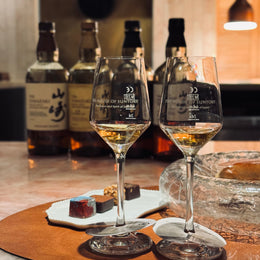
Gakki Masamune 楽器正宗 from Okidaikichi Honten in Fukushima has one of the prettiest designs I have seen on a sake label in quite some time. Visually appealing labels such as this are usually all the encouragement I need to buy sake. However, on this occasion, it was actually the Aiyama 愛山 rice that it was made from that sealed the deal.
Ever since I tasted an absolutely showstopping sake made by fellow kurabito and friend Jorge Navarette, I have been fixated with this somewhat mysterious rice from Hyogo. First cultivated in 1949, the intriguing story of how it came to prominence only adds to its allure. Due to an exclusive contract with sake behemoth Kenbishi in Nada, Aiyama was effectively hidden in plain sight for much of its early life. It was only after the tragic events of the Hanshin Earthquake in 1995 resulted in Kenbishi having to temporarily close, did it finally find itself in the hands of someone else. Considering that someone else was none other than Jyuyondai, it's little wonder that the spotlight was soon shining firmly on this hitherto obscure variety.
But what makes Aiyama so special that sake royalty such as Jyuyondai, all the way up in Northern Japan, a region famous for its abundance of quality rice, would take notice of this obscure variety from Hyogo? The answer is simple: pedigree.
Aiyama's ancestry reads like a venerable "who's who" of the sake world. A crossbreed of Aifune 愛船 117 and Yamao 山雄 67, it's name was formed by taking the first kanji character from each of these two parent strains. However, a look further down the family tree reveals that it's grandparents are actually two of the most famous in the business, Omachi and Yamada-Nishiki. It even has some Funaki-Omachi 船木雄町 on one side, a pure-strain Omachi that was once widely cultivated in Hiroshima prefecture. With ancestry like that, it's little wonder that Aiyama is often referred to as the "thoroughbred" sake rice.

As a result of this stellar breeding, Aiyama brings some seriously impressive qualities into the brewery. The all-important shinpaku, or starchy core, for example, is large, as is the grain itself. Indeed, it even trumps the mighty Yamada-Nishiki on this front, with a thousand-kernel weight 千粒重 of around 28.3g. Just to put that into context, anything over 26g is considered large, and Yamada-Nishiki and Omachi come in at approximately 27-28g and 26-27g respectively.
As is so often the case with high quality sake rice, there is a price to pay when brewing with it. I am reliably informed that Aiyama is particularly challenging to work with, perhaps even more so than the famously difficult Omachi. The large shinpaku, combined with a soft grain, means that it is susceptible to cracking during polishing, especially if done to the levels required for ginjo and daiginjo. Inside the brewery, too, it behaves like a bit of a diva, with it's soft grains absorbing water rapidly with a heightened sensitivity to temperature. This in turn makes soaking and steaming a fraught affair, to say the least. Furthermore, soft-grained rice such as this have high solubility in the mash, which increases the risk of off-flavours in the final sake.
If handled well, however, the reward for all of the challenges mentioned previously is the potential for a full-bodied sake with big, juicy, prominent flavours. As is evident in the superb balance of aroma, flavour and acidity in this Gakki Masamune, the brewers have definitely managed to coax that potential from the rice. The aromatics are not overpowering, yet you are greeted with a delightful aroma of Muscat well before you put your nose to the glass. As for flavour, it's juicy and fresh, with the rice imparting just enough sweetness to keep you coming back for more.
My only slight criticism would be to say that when chilled it does have a certain harshness, and I would strongly recommend letting it come up to just below room temperature before serving. At this temperature, the slight harshness will soften, aromas will become sweeter, and it will become more balanced.
Finally, I should also point out that this particular sake is not made entirely of Aiyama. Judging by the 83% listed on the label, it's a safe bet to assume that all the koji was made from another variety. This is actually quite common practice when handling these more challenging rice varieties, as trying to make koji from them can be nothing short of a nightmare. It would be interesting to know if this was a creative decision from the brewers, or whether they felt that the koji would be just too challenging at ginjo levels. Either way, it's a fantastic sake and a brilliant example of what this mercurial thoroughbred is capable of.

This piece was originally featured on Origin Sake.
Origin Sake aims to uncover the many fascinating and complex aspects of Japan's national beverage. Through a better understanding of brewing techniques, we can begin to unravel sake's numerous mysteries.
Head over to Origin Sake for more!
Website: Origin Sake
You can also support Origin Sake here.







